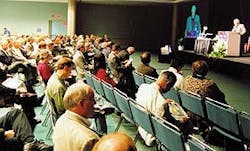While annual meetings of Optical Society of America (OSA; Washington, DC) are smaller than major events such as CLEO and OFC, attendance at this year's meeting held Oct. 14 to 18 seemed particularly low. That perception, however, may have been a result of the spaciousness of its location, the Long Beach Convention Center. Actually, this year's attendance figure of 1500 was only 200 below last year's total and represented about 10% of the organization's membership.
It was evident that economic doldrums as well as the continuation of hostilities that began Sept. 11 at the Pentagon and World Trade Center were key factors in this year's drop in attendance. It was not uncommon to walk into a technical session and find that a paper had been withdrawn because of travel restrictions. Despite the external factors, however, the meeting included many dynamic and interesting presentations. In addition, the OSA is considering initiatives to bolster meeting attendance and has already begun to reach out more effectively to professional and lay communities. An employment assistance website at www.workinoptics.com was rolled out Sept. 1, and an optics education site targeting school-aged children is scheduled for debut in the first quarter of next year. A month and a half after first coming online, the workinoptics website had accumulated almost 700 job listings from just over 300 employers. Almost 700 job seekers had registered with the site and almost 400 had posted resumes.
The meeting's theme of entrepreneurship in optics was well-served by three plenary speakers. Neal Lane, former director of the National Science Foundation and White House assistant to the President for science and technology, discussed entrepreneurship and science policy. Milton Chang, former chairman of New Focus (San Jose, CA) and chairman of Arcturus Engineering (Mountain View, CA) and OEpic (Sunnyvale, CA), discussed lessons that he had learned in a successful entrepreneurial career. And Jack Gill, general partner of Vanguard Venture Partners (Palo Alto, CA) discussed important trends in optics and communications.
A primary entrepreneurial opportunity for optics in terms of science policy lies in better educating the public, Lane said. He argued that science and technology are increasingly important, but most people and politicians don't know anything about it.
Silver lining
The impact of Chang's inspiring discussion of lessons he learned was as much in the message itself—that we must give in order to get—as in the competent and down-to-earth manner in which the message was delivered. Chang offered hardnosed advice that would-be entrepreneurs must "balance professionalism with compassion and not the other way around." But he also emphasized the importance of finding the benefit in every situation. For instance, Chang said the telecom bubble had been "created by serving the needs of Wall St." and would be "corrected by serving the needs of the customer." And in reference to the Sept. 11 World Trade Center and Pentagon attacks, he said that "world events accentuate the need for lasting peace."
Gill's talk focused primarily on the transition from electrons to photons as the primary culture-building technology of the 21st Century. After five decades of development through medium, large and very large-scale integration, electronics, with tens of millions of transistors on a chip and line widths down to a few atoms wide is approaching its natural physical limits, he said. Photonics, however, is still in the single-device and early integration levels corresponding to the transistor and integrated circuit eras in electronics. Of course, the major driver for optoelectronic integration to date has come from the communication industry, and Gill also discussed the accompanying changes in business models and financing strategies, particularly in light of the boom and bust of the telecom bubble. "Nowhere in recent times, has more money been invested or have more innovations been made with a greater impact on life than in the communications industry in the last decade," he said. Even though the excessive overfunding of the optical communication sector during the last three years has led to a drastic market correction this year, Gill projected that the $3 billion was nonetheless invested in innovations that will ultimately enable an "all-optical communications world."
Among trends discussed in the technical sessions, optical design engineers from Optical Research Associates (ORA; Pasadena, CA), Breault Research Organization (BRO; Tucson, AZ) and Photon Engineering (Tuscon, AZ) discussed the growing importance of illumination design and compared current capabilities for automating the design process with established methods for automated imaging design. For instance, imaging design generally calls for minimizing spot size, a one-to-one correlation between source and receiver, a relatively small object numerical aperture, and a sequential system of optical elements. In illumination problems, on the other hand, one seeks a prescribed beam distribution, source-independent illumination at the receiver, a large source numerical aperture, and a parallel distribution of optical elements.
One of the most important differences in illumination design, perhaps, is that the human visual system is often the detector and that environment as well as numerous subjective factors must also be considered. "Illumination engineers cannot only consider technical aspects of design," said R. John Koshel of BRO.
About the Author
Hassaun A. Jones-Bey
Senior Editor and Freelance Writer
Hassaun A. Jones-Bey was a senior editor and then freelance writer for Laser Focus World.
